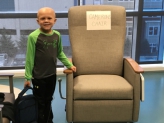Defining the Cell Surface Landscape of Diagnostic and Relapsed Neuroblastoma: Immunotherapeutic Target Identification
Background
Neuroblastoma (NB) is a childhood cancer of the developing sympathetic nervous system that is often fatal. Despite intense therapy, the survival rate for high-risk NB remains less than 50% and relapsed NB is almost universally incurable. Utilizing one's immune system to fight cancer has shown remarkable results in both childhood and adult malignancies. Ideal immunotherapeutic targets are proteins expressed on the surface of cancerous cells, but absent on normal cells.
Project Goal
Here, we will apply state-of-the-art proteomic approaches together with DNA and RNA sequencing in NB patient tumor samples to define the landscape of cell surface expression in NB at diagnosis and relapse. Normal tissue expression will be evaluated in 7,859 samples and NB-specific cell surface proteins will be validated, characterized and prioritized for possible downstream therapy development. The expected outcomes of this project include 1) delivery of the definable landscape of cell surface protein expression in NB, including how these proteins evolve under the pressure of chemotherapy, and 2) a high confidence set of validated NB cell surface proteins to undergo a downstream assessment of suitability for immunotherapeutic targeting. As a result, this work will have a sustained and positive impact on the treatment and outcome of children with NB and potentially other high-risk childhood cancers.
Project Update - June 2020
Support from Year 1 of this ALSF Innovation Award has already enabled us to make great strides toward defining the repertoire of proteins preferentially expressed on the surface of neuroblastoma cells that may serve as targets for new immunotherapies. Using a proteogenomic approach, we selected DLK1 as a potential target in neuroblastoma. We have further validated cell surface expression, demonstrated minimal expression in normal tissues, discovered an epigenetic mechanism driving increased DLK1 expression, and shown that expression of this protein impedes differentiation thereby promoting tumorigenesis. Collectively, these efforts prioritize DLK1 for immunotherapeutic drug development and downstream pre-clinical testing.

